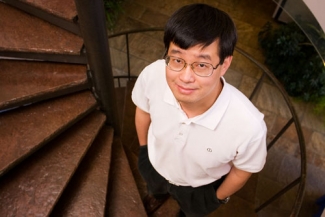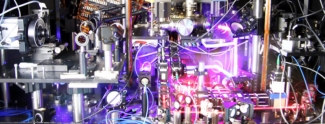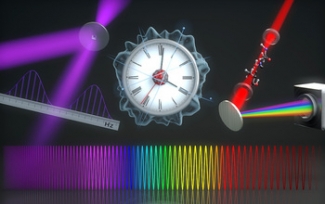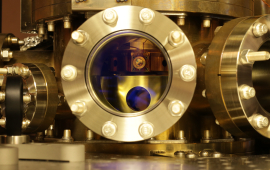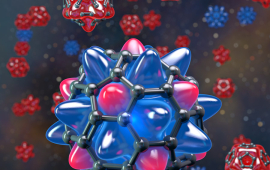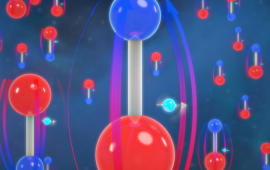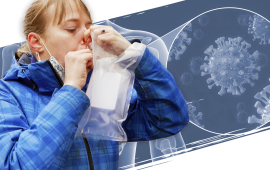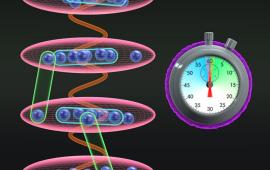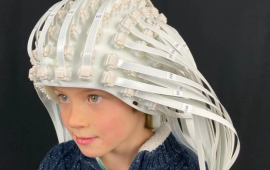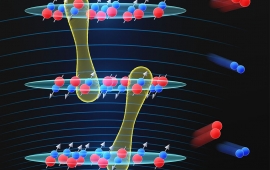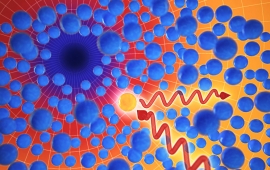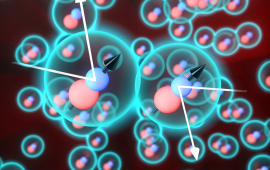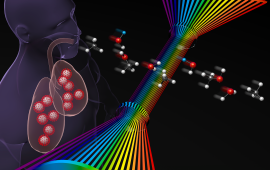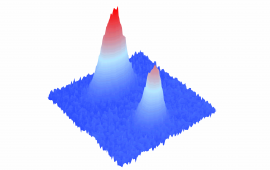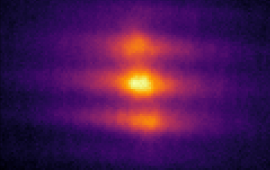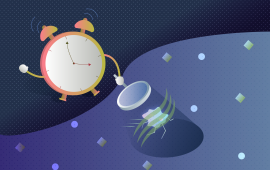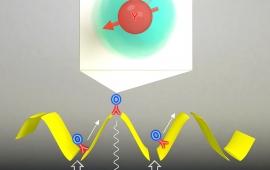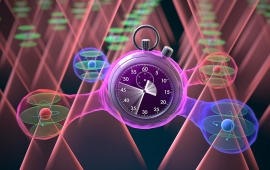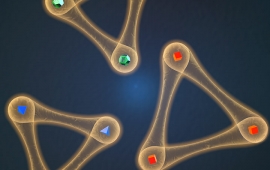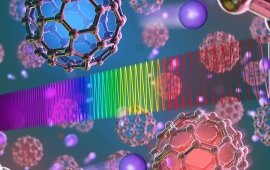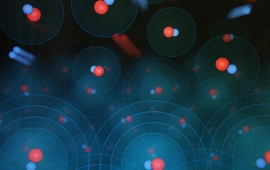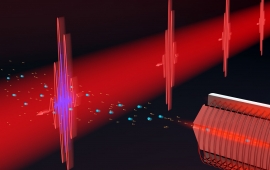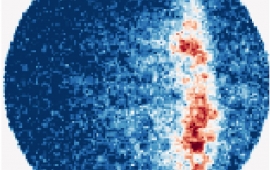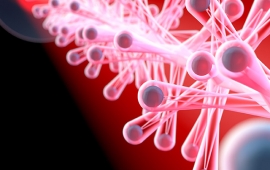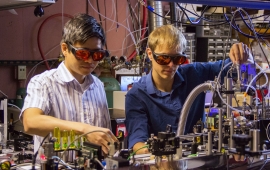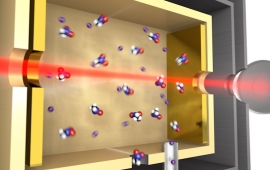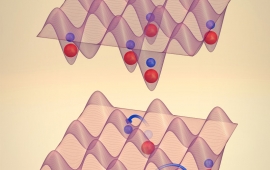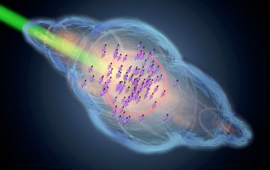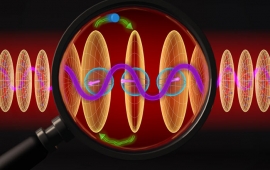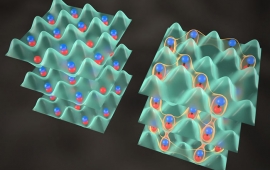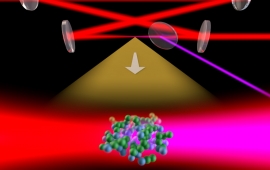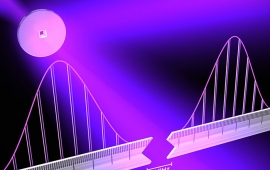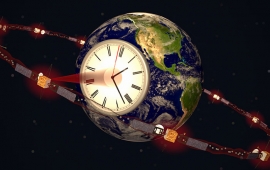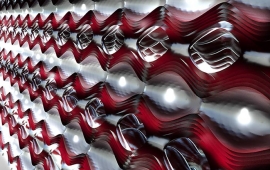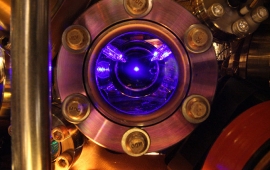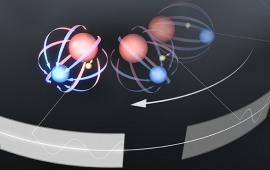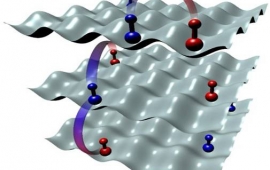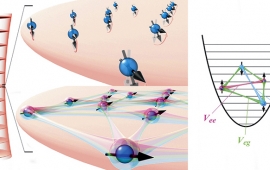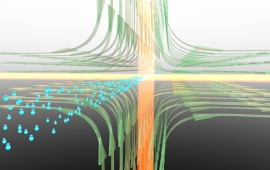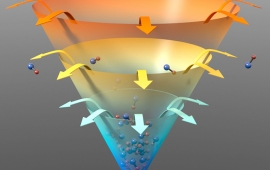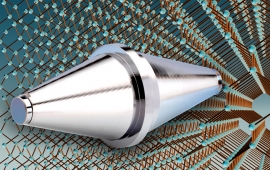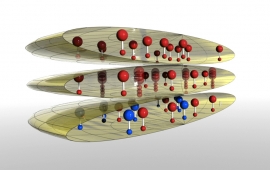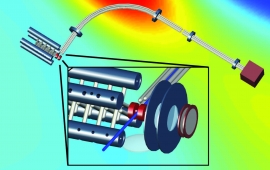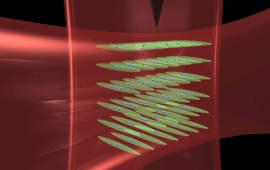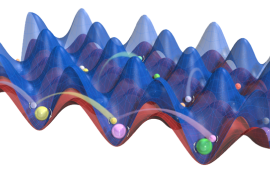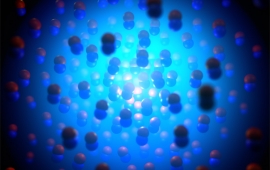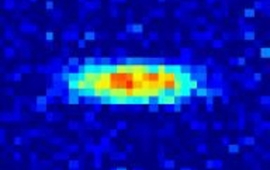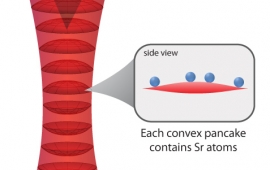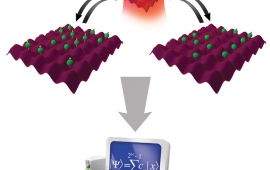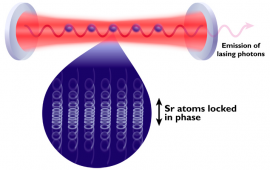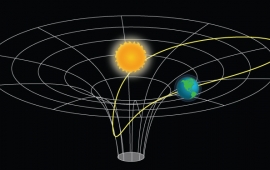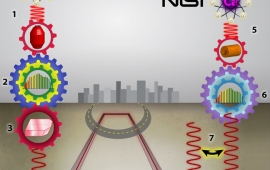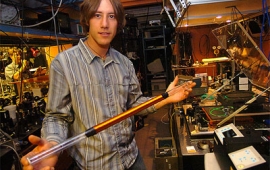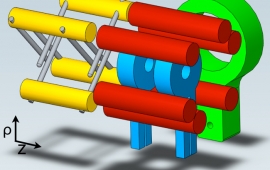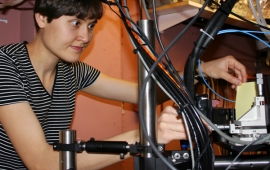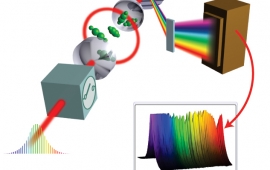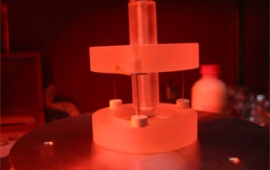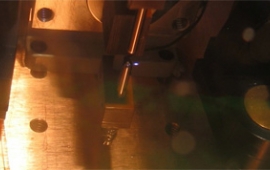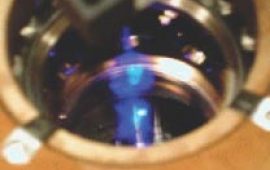Our group explores many facets of ultracold strontium (Sr), emphasizing precision measurement and quantum state engineering and manipulation of atomic states. The group has achieved exquisite technical control via precision stabilization of lasers and the realization of ultracold atoms in optical lattices. Early on, we focused on precision measurements of Sr electronic transitions, which occur at optical frequencies, to explore the possibility of developing an optical atomic clock.
About the Ye Group
Quantum science and precision metrology — quantum matter probed with novel light source
Our research group explores the frontier of light-matter interactions. Precisely controlled lasers enable our communications with microscopically engineered quantum systems of atoms and molecules. By preparing matter in specific quantum states, and using probe light with the longest coherence time and precisely controlled waveform, we strive to make fundamental scientific discoveries and develop new enabling technologies.
The strongly integrated development of scientific vision and experimental tools has enabled us to advance important topics in precision measurement, quantum many-body physics, quantum metrology, ultrafast science, and quantum science in general. For example, we employ quantum gas of strontium atoms confined in optical lattices to achieve best performing atomic clocks and investigate novel quantum dynamics, combining quantum metrology and quantum simulation. We prepare molecules in quantum degenerate gases to engineer tunable Hamiltonians for correlated quantum phenomena. These quantum-state prepared molecules are also explored for test of fundamental physics and study of quantum chemistry. Stable lasers and optical frequency combs are extending precision spectroscopy and extreme nonlinear optics from mid infrared to extreme ultraviolet, providing novel probes for large quantum systems, trace detection for health and environment, and new spectroscopy opportunities for nuclear transitions.
Research Areas
Since 1999 and 2000, there has been a remarkable convergence of the fields of ultrafast optics, opti cal frequency metrology, and precision laser spectroscopy — a convergence that our lab was privileged to help facilitate. A remarkable transformation took place in these fields as unprecedented advances occurred in the control of optical phases ranging from the ultrashort (femtoseconds) to laboratory time scales (seconds). Today, a single-frequency continuous optical field can achieve a phase coherence time exceeding 1 s. This phase coherence can be precisely transferred to the electric waveform of an ultrafast pulse train!
Molecules cooled to ultralow temperatures provide fundamental new insights to molecular interaction dynamics in the quantum regime. In recent years, researchers from various scientific disciplines such as atomic, optical, and condensed matter physics, physical chemistry, and quantum science have started working together to explore many emergent research topics related to cold molecules, including cold chemistry, strongly correlated quantum systems, novel quantum phases, and precision measurement. The exceedingly low energy regimes for ultracold molecules represent a new playground for chemical physics where quantum behaviors play a dominant role in molecular interaction and dynamics. Unique and complex molecular energy structure provides new opportunities for sensitive probe of fundamental physics. The anisotropic and long-range dipolar interactions add new ingredients to strongly correlated and collective quantum dynamics in many-body systems.
Stories About Our Research
Entangled Time: Pushing Atomic Clocks Beyond the Standard Quantum Limit
In a new study, researchers led by JILA and NIST Fellow Jun Ye have shown how to make atomic clocks even more precise by leveraging entanglement. This allows the atoms to “tick” more in sync, reducing the randomness that usually limits…
Read MoreTailoring Record-Breaking Laser Stability for Coordinating Precise Atomic Dances
Jun Ye's research group has developed a groundbreaking laser system with record-breaking stability, crucial for advancing quantum technologies. By combining a highly stable silicon cavity laser with a frequency comb and a secondary…
Read MoreSmoother Ticking Through Topology
In a new theoretical study, physicists at JILA and the University of Colorado Boulder have proposed a way to make the most precise clocks in the world even more robust—by weaving in the strange, protective properties of topological…
Read More
The Pursuit of Perfect Timekeeping
In a recent study published in Science, by JILA and NIST Fellows and University of Colorado Boulder physics professors Jun Ye and Ana Maria Rey, interactions between atoms are explored in depth, focusing on…
Read MoreWhere Motion Meets Spin: A Quantum Leap in Simulating Magnetism
The strange behaviors of high-temperature superconductors—materials that conduct electricity without resistance above the boiling point of liquid nitrogen—and other systems with unusual magnetic properties have fascinated scientists for…
Read MoreDialing in the Temperature Needed for Precise Nuclear Timekeeping
For decades, atomic clocks have been the pinnacle of precision timekeeping, enabling GPS navigation, cutting-edge physics research, and tests of fundamental theories. But researchers at JILA, led by JILA and NIST Fellow and University…
Read More
Using Frequency Combs to Detect Molecules in Your Breath
A team of physicists at the University of Colorado Boulder and the National Institute of Standards and Technology (NIST) has developed a groundbreaking laser-based…
Read MoreSneaky Clocks: Uncovering Einstein’s Relativity in an Interacting Atomic Playground
For over a century, physicists have grappled with one of the most profound questions in science: How do the rules of quantum mechanics, which govern the smallest particles, fit with the laws of general relativity, which describe the…
Read MoreBuilding a Safer and More Affordable Nuclear Clock
In the quest for ultra-precise timekeeping, scientists have turned to nuclear clocks. Unlike optical atomic clocks—which rely on electronic transitions—nuclear clocks utilize the energy transitions in the atom’s nucleus, which are less…
Read More
Polar Molecules Dance to the Tunes of Microwaves
The interactions between quantum spins underlie some of the universe’s most interesting phenomena, such as superconductors and magnets. However, physicists have difficulty engineering controllable systems in the lab that replicate these…
Read MoreMoving into a Nuclear Timekeeping Domain
An international team of researchers, led by JILA and NIST Fellow and University of Colorado Boulder Physics Professor Jun Ye and his team, has made significant strides in developing a groundbreaking timekeeping device known as a…
Read MoreJILA Researchers Create an Even More Precise Optical Atomic Clock
JILA and NIST Fellow and University of Colorado Boulder Physics professor Jun Ye and his team at JILA, a collaboration between NIST and the University of Colorado Boulder, have developed an atomic clock of unprecedented precision…
Read More
Building on JILA’s Legacy of Laser Precision
Within atomic and laser physics communities, scientist John “Jan” Hall is a key figure in the history of laser frequency stabilization and precision measurement using lasers. Hall's work revolved around understanding and manipulating…
Read MoreThe Tale of Two Clocks: Advancing the Precision of Timekeeping
Historically, JILA (a joint institute established by the National Institute of Standards and Technology (NIST) and the University of Colorado Boulder) has been a world leader in precision timekeeping using optical atomic clocks. These…
Read More
Sizing Up an Electron’s Shape
Some of the biggest questions about our universe may be solved by scientists using its tiniest particles. Since the 1960s, physicists have been looking at particle interactions to understand an observed imbalance of matter and…
Read MoreUsing Frequency Comb Lasers as a Breathalyzer for COVID-19
JILA researchers have upgraded a breathalyzer based on Nobel Prize-winning frequency-comb technology and combined it with machine learning to detect SARS-CoV-2 infection in 170 volunteer subjects with excellent accuracy. Their…
Read More
Controlling a Quantum Classroom: New Insights into the Spin-Dynamics of Molecules
Quantum gases of interacting molecules can exhibit unique dynamics. JILA and NIST Physicist Jun Ye has spent years of research to reveal, probe, and control these dynamics with potassium-rubidium molecules. In a new article published in…
Read MoreA Magic Balance in Optical Lattice Clocks
Atomic clocks are essential in building a precise time standard for the world, which is a big focus for researchers at JILA. JILA and NIST Fellow Jun Ye, in particular, has studied atomic clocks for two decades, looking into ways to…
Read MoreA Look at Colorado's Quantum Revolution
More than 400 years later, scientists are in the midst of an equally-important revolution. They’re diving into a previously-hidden realm—far wilder than anything van Leeuwenhoek, known as the “father of microbiology,” could have…
Read More
An Atomic Game of Duck, Duck, Goose
Physics has always been a science of rules. In many situations, these rules lead to clear and simple theoretical predictions which, nevertheless, are hard to observe in actual experimental settings where other confounding effects may…
Read MoreElectrifying Molecular Interactions
Worldwide, many researchers are interested in controlling atomic and molecular interactions. This includes JILA and NIST fellows Jun Ye and Ana Maria Rey, both of whom have spent years researching interacting potassium-rubidium (KRb)…
Read MoreJILA Atomic Clocks Measure Einstein’s General Relativity at Millimeter Scale
JILA physicists have measured Albert Einstein’s theory of general relativity, or more specifically, the effect called time dilation, at the smallest scale ever, showing that two tiny atomic clocks, separated by just a millimeter or the…
Read More
Colorado Congressman Joe Neguse tours JILA
Last week, U.S. Rep. Joe Neguse got a first-hand look at the future of ultrafast lasers, record-setting clocks, and quantum computers on the CU Boulder campus. Neguse visited the university Thursday to tour …
Read MoreAtomic Musical Chairs
How atoms interact with light reflects some of the most basic principles in physics. On a quantum level, how atoms and light interact has been a topic of interest in the worldwide scientific community for many years. Light scattering is…
Read MoreHelp Wanted: How to Build a Prepared and Diverse Quantum Workforce
The second quantum revolution is underway, a period marked by significant advances in quantum technology, and huge discoveries within quantum science. From tech giants like Google and IBM, who build their own quantum computers, to…
Read More
Don’t React, Interact: Looking Into Inert Molecular Gases
One of the major strengths of JILA are the frequent and ongoing collaborations between experimentalists and theorists, which have led to incredible discoveries in physics. One of these partnerships is between JILA Fellow John Bohn and…
Read MoreWhen Breath Becomes Data
There are many ways to diagnose health conditions. One of the most common methods is blood testing. This sort of test can look for hundreds of different kinds of molecules in the body to determine if an individual has any diseases or…
Read MoreWiggles in Time: The Search for Dark Matter Continues
In a new paper published in Physical Review Letters, JILA and NIST Fellows Eric Cornell, Jun Ye, and Konrad Lehnert developed a method for measuring a potential dark matter candidate, known as an axion-like particle. Axion-like…
Read More
NIST Team Compares 3 Top Atomic Clocks With Record Accuracy Over Both Fiber and Air
In a significant advance toward the future redefinition of the international unit of time, the second, a research team led by the National Institute of Standards and Technology (NIST) has compared three of the world’s leading atomic…
Read MoreMolecules in Flat Lands: an Entanglement Paradise
Entangled particles have always fascinated physicists, as measuring one entangled particle can result in a change in another entangled particle, famously dismissed as “spooky action at a distance” by Einstein. By now, physicists…
Read MoreNew JILA Tools ‘Turn On’ Quantum Gases of Ultracold Molecules
For the first time, researchers can turn on an electric field to manipulate molecular interactions, get them to cool down further, and start to explore collective physics where all molecules are coupled to each other.
Read More
JILA’s Electric ‘Knob’ Tunes Chemical Reaction Rates in Quantum Gas
Building on their newfound ability to induce molecules in ultracold gases to interact with each other over long distances, JILA researchers have used an electric “knob” to influence molecular collisions and dramatically raise or lower…
Read MoreAdvanced Atomic Clock Makes a Better Dark Matter Detector
JILA researchers have used a state-of-the-art atomic clock to narrow the search for elusive dark matter, an example of how continual improvements in clocks have value beyond timekeeping.
Read MoreTotal Ellipse of the SU(N)
A strangely shaped cloud of fermions revealed a record-fast way of cooling atoms for quantum devices.
Read More
The Sisyphean Task of Cooling Molecules
Bringing molecules down to ultracold temperatures takes a mythic approach, but the Ye Group finds that their new scheme can hold up under tough conditions.
Read MoreTweezing a New Kind of Atomic Clock
Using optical tweezers, the Kaufman and Ye groups at JILA have achieved record coherence times, an important advance for optical clocks and quantum computing.
Read MoreHow universal is universality?
New research from the Cornell Group suggests that the van der Waals universality may have limitations.
Read More
Keep it steady
It's hard to read a clock with hands that wobble. The Ye Group has found a way to steady their optical atomic clock using a new cavity.
Read MoreBuckyballs Play by Quantum Rules
When the Ye group measured the total quantum state of buckyballs, we learned that this large molecule can play by full quantum rules. Specifically, this measurement resolved the rotational…
Read MoreThe First Quantum Degenerate Polar Molecules
Understanding chemistry requires understanding both molecules and quantum physics. The former defines the start and end of chemical reactions, the latter dictates the dynamics in between. JILA researchers now have a better understanding…
Read More
Turn it Up to 11 – The XUV Comb
With the advent of the laser, the fuzzy bands glowing from atoms transformed into narrow lines of distinct color. These spectral lines became guiding beacons visible from the quantum frontier. More than a half century later, we stand at…
Read MoreSame Clock. New Perspective.
We all know what a tenth of a second feels like. It’s a jiffy, a snap of the fingers, or a camera shutter click. But what does 14 billion years–the age of the universe–feel like? JILA’s atomic clock has the precision to measure the age…
Read MoreThe Energetic Adolescence of Carbon Dioxide
The reaction, at first glance, seems simple. Combustion engines, such as those in your car, form carbon monoxide (CO). Sunlight converts atmospheric water into a highly reactive hydroxyl radical (OH). And when CO and OH meet, one…
Read More
And, The Answer Is . . . Still Round
Why are we here? This is an age-old philosophical question. However, physicists like Will Cairncross, Dan Gresh and their advisors Eric Cornell and Jun Ye actually want to figure out out why people like us exist at all. If there had…
Read MoreThe Clock that Changed the World
Imagine A Future . . . The International Moon Station team is busy on the Moon’s surface using sensitive detectors of gravity and magnetic and electric fields looking for underground water-rich materials, iron-containing ores, and…
Read MoreQuantum Adventures with Cold Molecules
Researchers at JILA and around the world are starting a grand adventure of precisely controlling the internal and external quantum states of ultracold molecules after years of intense experimental and theoretical study. Such control of…
Read More
Quantum Leaps
In the Ye group’s new quantum simulation experiment, cold strontium atoms, which are analogs of electrons, are allowed to tunnel between the pancakes that confine the atoms with laser light. Because the atoms moving in an array of…
Read MoreMolecules at the Quantum Frontier
Deborah Jin, Jun Ye, and their students wrote a review during the summer of 2016 for Nature Physics highlighting the accomplishments and future directions of the relatively new field of ultracold-molecule research.…
Read MoreThe Radical Comb-Over
Using frequency comb spectroscopy, the Ye group has directly observed transient intermediate steps in a chemical reaction that plays a key role in combustion, atmospheric chemistry, and chemistry in the interstellar medium. The group…
Read More
Stalking the Wild Molecules
The Ye group just solved a major problem for using molecular fingerprinting techniques to identify large, complex molecules: The researchers used an infrared (IR) frequency comb laser to identify four different large…
Read MoreThe Ultramodern Molecule Factory: I. Doublons
The old JILA molecule factory (built in 2002) produced the world’s first ultracold polar molecules [potassium-rubidium (KRb)] in 2008. The old factory has been used since then for ultracold chemistry investigations and studies of the…
Read MoreQuantum Baseball
The Ye and Rey groups have discovered the strange rules of quantum baseball in which strontium (Sr) atoms are the players, and photons of light are the balls. The balls control the players by not only getting the atoms excited, but also…
Read More
Creative Adventures in Coupling
The Rey and Ye groups are in the midst of an extended collaboration on using the Ye group’s strontium (Sr) lattice clock for studies of spin-orbit coupling in pancake-like layers of cold Sr atoms. Spin-orbit coupling means an atom’s…
Read MoreA Thousand Splendid Pairs
JILA’s cold molecule collaboration (Jin and Ye Groups, with theory support from the Rey Group) recently made a breakthrough in its efforts to use ultracold polar molecules to study the complex physics of large numbers of interacting…
Read MoreAbout Time
The Ye group has just improved the accuracy of the world’s best optical atomic clock by another factor of three and set a new record for clock stability. The accuracy and stability of the improved strontium lattice optical clocks is now…
Read More
A Bug’s Life
The Ye Group recently investigated what first appeared to be a “bug” in an experiment and made an unexpected discovery about a new way to generate high-harmonic light using molecular gases rather than gases of noble atoms. Graduate…
Read MoreAtoms, Atoms, Frozen Tight in the Crystals of the Light, What Immortal Hand or Eye Could Frame Thy Fearful Symmetry?
Symmetries described by SU(N) group theory made it possible for physicists in the 1950s to explain how quarks combine to make protons and neutrons and JILA theorists in 2013 to model the behavior of atoms inside a laser. Now, the Ye…
Read MoreInvisible Rulers of Light
The Ye group has not only made two invisible rulers of extreme ultraviolet (XUV) light, but also figured out how to observe them with ordinary laboratory electronics. With this setup, the researchers were able to prove that the two…
Read More
Sky Clocks and the World of Tomorrow
Imagine a network of multiple clocks orbiting the Earth, not only reporting down to us, but also collaborating quantum mechanically among themselves to operate precisely in sync as a single global superclock, or world clock. The world…
Read MoreDealing with Loss
There’s exciting news from JILA’s ultracold molecule collaboration. The Jin, Ye, Holland, and Rey groups have come up with new theory (verified by experiment) that explains the suppression of chemical reactions between potassium-…
Read MoreA Clockwork Blue Takes the Gold
JILA and NIST labs are well on the way to creating astonishingly accurate optical atomic clocks based on the neutral atoms strontium (Sr) and ytterbium (Yb). The new technologies are already capable of the most meticulous timekeeping in…
Read More
The Dipolar Express
Physicists wonder about some pretty strange things. For instance, one burning question is: How round is the electron? While the simplest picture of the electron is a perfect sphere, it is possible that it is instead shaped like an egg.…
Read MoreThe Great Spin Swap
Research associate Bo Yan and his colleagues recently observed spin exchanges in ultracold potassium-rubidium (KRb) molecules inside an optical lattice (a crystal of light formed by interacting laser beams). In solid materials, such…
Read MoreThe Magnificent Quantum Laboratory
Because quantum mechanics is crucial to understanding the behavior of everything in the Universe, one can understand key elements of the behavior of a neutron star by investigating the behavior of an atomic system in the laboratory.…
Read More
Trapper Marmot and the Stone Cold Molecules
The Ye group has opened a new gateway into the relatively unexplored terrain of ultracold chemistry. Research associate Matt Hummon, graduate students Mark Yeo and Alejandra Collopy, newly minted Ph.D. Ben Stuhl, Fellow Jun Ye, and a…
Read MoreThe Big Chill
The Ye and Bohn groups have made a major advance in the quest to prepare “real-world” molecules at ultracold temperatures. As recently reported in Nature, graduate students Ben Stuhl and Mark Yeo, research associate Matt…
Read MoreThe Most Stable Clock in the World
The world’s most stable optical atomic clock resides in the Ye lab in the basement of JILA’s S-Wing. The strontium-(Sr-)lattice clock is so stable that its frequency measurements don’t vary by more than 1 part in 100 quadrillion (1 x 10…
Read More
New Silicon Cavity Silences Laser Noise
Researchers from a German national laboratory, the Physikalisch-Technische Bundesanstalt (PTB) have collaborated with Fellow Jun Ye, Visiting Fellow Lisheng Chen (Wuhan Institute of Physics and Mathematics, Chinese Academy of Sciences…
Read MoreThe Indomitable Ruler of Light
The Ye group has created the world’s first “ruler of light” in the extreme ultraviolet (XUV). The new ruler is also known more formally as the XUV frequency comb. The comb consists of hundreds of equally spaced “colors” that function in…
Read MoreUltracold Polar Molecules to the Rescue!
Physicists would very much like to understand the physics underlying high-temperature superconductors. Such an understanding may lead to the design of room temperature superconductors for use in highly efficient and much lower-cost…
Read More
The Cold Case
The Ye group has built a cool new system for studying cold collisions between molecules. The system is far colder than a typical chemistry experiment that takes place at room temperature or hotter (300–500 K). But, it’s also much warmer…
Read MoreThe Quantum Control Room
In 2008, the Ye and Jin groups succeeded in making ultracold potassium-rubidium (KRb) molecules in their ground state (See “Redefining Chemistry at JILA” in the Spring 2010 issue of JILA Light & Matter). Their next goal was to…
Read MoreStrontium Clock Performance Skyrockets
In 2008-2009, much to their amazement,researchers working on the Jun Ye group’s neutral Sr optical atomic clock discovered tiny frequency shifts caused by colliding fermions! They figured out that the clock laser was…
Read More
The Quantum Modeling Agency
“Nature is built quantum mechanically,” says Fellow Jun Ye, who wants to understand the connections between atoms and molecules in complex systems such as liquids and solids (aka condensed matter). He says that the whole Universe is…
Read MoreDeciphering Nature's Fingerprints
Fellow Jun Ye’s group has enhanced the molecular fingerprinting technique with the development of a mid-infrared (mid-IR) frequency comb. The new rapid-detection technique can now identify traces of a wider variety of molecules…
Read MoreRedefining Chemistry at JILA
Fellows Deborah Jin, Jun Ye, and John Bohn are exploring new scientific territory in cold-molecule chemistry. Experimentalists Jin and Ye and their colleagues can now manipulate, observe, and control ultralow-temperature potassium-…
Read More
Freeze Frame
The cold-molecule collaboration has developed a method for directly imaging ultracold ground-state KRb molecules. Their old method required the transfer of ultracold KRb molecules into a Feshbach state, which is sensitive to electric…
Read MoreFermions in Collision?
According to the laws of quantum mechanics, identical fermions at very low temperatures can’t collide. These unfriendly subatomic particles, atoms, or molecules simply will not share the same piece of real estate with an identical twin…
Read MoreThe Right Stuff
In the summer of 2008, Fellow Jun Ye spent a couple of months at CalTech, where he ran into another visiting professor, former JILA Fellow Peter Zoller. Zoller left JILA in 1994 to become Professor of Physics at the University of…
Read More
A Quantum Leap for Precision Lasers
To be the best they can be, optical atomic clocks need better clock lasers — lasers that remain phase coherent a hundred times longer than the very best conventional lasers. For instance, light from the clock laser in Fellow Jun Ye’s…
Read MoreBeams In Collision
Last year the Ye group conducted an actual laboratory astrophysics experiment. Graduate students Brian Sawyer, Ben Stuhl, and Mark Yeo, research associate Dajun Wang, and Fellow Jun Ye fired cold hydroxyl (OH) radicals into a linear…
Read MoreStalking the X-Ray Frequency Comb
Fellow Jun Ye’s group is methodically working its way toward the creation of an X-Ray frequency comb. Recently, senior research associate Thomas Schibli, graduate student Dylan Yost, Fellow Jun Ye, and colleagues from IMRA America, Inc…
Read More
The Gravity of the Situation
What sort of experiment could detect the effects of quantum gravity, if it exists? Theories that go beyond the Standard Model of physics include a concept that links quantum interactions with gravity. Physicists would very much like to…
Read MoreClock Talk
By late 2006, Fellow Jun Ye’s clock team had raised the accuracy of its strontium (Sr)-lattice atomic clock to be just shy of that of the nation’s primary time and frequency standard, the NIST-F1 cesium (Cs) fountain clock. Graduate…
Read MoreEvery Breath You Take
With every breath you take, you breathe out carbon dioxide and roughly 1000 other different molecules. Some of these can signal the early onset of such diseases as asthma, cystic fibrosis, or cancer. Thanks to graduate student Mike…
Read More
Lights, Magnets, Action!
When the Jin and Ye group collaboration wanted to investigate the creation of stable ultracold polar molecules, the researchers initially decided to make ultracold KRb (potassium-rubidium) molecules and then study their collision…
Read MoreExploring a Cold New World
Researchers from the Ye, Bohn, and Greene groups are busy exploring a cold new world crawling with polar hydroxyl radical (OH) molecules. The JILA experimentalists have already discovered how to cool OH to “lukewarm” temperatures of 30…
Read MoreThe South Broadway Shootout
In the race to develop the world's best optical atomic clock, accuracy and precision are what count. Accuracy is the degree to which a measurement of time conforms to time's true value. Precision is a gauge of the exactness, or…
Read More
Magic Light
"In the right light, in the right time, everything is extraordinary," according to photographer Aaron Rose. He could have just as easily been describing precision optical spectroscopy experiments recently conducted by Research…
Read MorePartnership in Time
There's only one way to prove you've invented a better atomic clock: Come out on top of a comparison of your clock with one of the world's best atomic clocks: The NIST-F1 cesium fountain atomic clock, the nation's primary time and…
Read MoreMolecular Fingerprinting
Science sleuths have a new and powerful method for identifying (and investigating) atoms and molecules, thanks to Graduate Student Mike Thorpe, Research Associate Kevin Moll, Senior Research Associate Jason Jones, Undergraduate Student…
Read More
Time Traveling
Scientists in Fellow Jun Ye's lab are developing a high-precision optical atomic clock linked to super-narrow optical transitions in ultracold, trapped strontium atoms. However, unless the new clock is portable (it is not) or…
Read MoreThe Quest for Stability
Fellow Jan Hall has been working on stabilizing the frequency of lasers since the 1960s. Now, he, JILA Research Associate Mark Notcutt, Long-Sheng Ma (currently at BIPM in France), and Fellow Jun Ye have devised an improved, compact,…
Read MoreThe World's First UV Frequency Comb
Jason Jones, Kevin Moll, Mike Thorpe, and Jun Ye have generated the world's first precise frequency comb in the extreme ultraviolet (EUV) using a combination of an ultrafast mode-locked laser and a precision high-finesse optical cavity…
Read More
The Power of Mirrors
Three years ago Jun Ye decided to apply an old idea for amplifying and stabilizing continuous-wave (cw) lasers to state-of-the-art ultrafast lasers. In 2002, Jason Jones, a postdoctoral fellow with Jun, analyzed whether the build-up…
Read MoreThere's Strontium in the Clock
A high-powered JILA collaboration led by JILA Fellows Jun Ye and Chris Greene is making important progress toward developing an ultrastable, high-accuracy optical atomic clock. The new optical clock design will use a variety of laser…
Read More
Research Highlights
Entangled Time: Pushing Atomic Clocks Beyond the Standard Quantum Limit
In a new study, researchers led by JILA and NIST Fellow Jun Ye have shown how to make atomic clocks even more precise by leveraging entanglement. This allows the atoms to “tick” more in sync, reducing the randomness that usually limits…
Read More
Tailoring Record-Breaking Laser Stability for Coordinating Precise Atomic Dances
Jun Ye's research group has developed a groundbreaking laser system with record-breaking stability, crucial for advancing quantum technologies. By combining a highly stable silicon cavity laser with a frequency comb and a secondary…
Read More
Smoother Ticking Through Topology
In a new theoretical study, physicists at JILA and the University of Colorado Boulder have proposed a way to make the most precise clocks in the world even more robust—by weaving in the strange, protective properties of topological…
Read More
The Pursuit of Perfect Timekeeping
In a recent study published in Science, by JILA and NIST Fellows and University of Colorado Boulder physics professors Jun Ye and Ana Maria Rey, interactions between atoms are explored in depth, focusing on…
Read More
Where Motion Meets Spin: A Quantum Leap in Simulating Magnetism
The strange behaviors of high-temperature superconductors—materials that conduct electricity without resistance above the boiling point of liquid nitrogen—and other systems with unusual magnetic properties have fascinated scientists for…
Read More
Dialing in the Temperature Needed for Precise Nuclear Timekeeping
For decades, atomic clocks have been the pinnacle of precision timekeeping, enabling GPS navigation, cutting-edge physics research, and tests of fundamental theories. But researchers at JILA, led by JILA and NIST Fellow and University…
Read More
Using Frequency Combs to Detect Molecules in Your Breath
A team of physicists at the University of Colorado Boulder and the National Institute of Standards and Technology (NIST) has developed a groundbreaking laser-based…
Read More
Sneaky Clocks: Uncovering Einstein’s Relativity in an Interacting Atomic Playground
For over a century, physicists have grappled with one of the most profound questions in science: How do the rules of quantum mechanics, which govern the smallest particles, fit with the laws of general relativity, which describe the…
Read More
Building a Safer and More Affordable Nuclear Clock
In the quest for ultra-precise timekeeping, scientists have turned to nuclear clocks. Unlike optical atomic clocks—which rely on electronic transitions—nuclear clocks utilize the energy transitions in the atom’s nucleus, which are less…
Read More
Polar Molecules Dance to the Tunes of Microwaves
The interactions between quantum spins underlie some of the universe’s most interesting phenomena, such as superconductors and magnets. However, physicists have difficulty engineering controllable systems in the lab that replicate these…
Read More
Moving into a Nuclear Timekeeping Domain
An international team of researchers, led by JILA and NIST Fellow and University of Colorado Boulder Physics Professor Jun Ye and his team, has made significant strides in developing a groundbreaking timekeeping device known as a…
Read More
JILA Researchers Create an Even More Precise Optical Atomic Clock
JILA and NIST Fellow and University of Colorado Boulder Physics professor Jun Ye and his team at JILA, a collaboration between NIST and the University of Colorado Boulder, have developed an atomic clock of unprecedented precision…
Read More
Building on JILA’s Legacy of Laser Precision
Within atomic and laser physics communities, scientist John “Jan” Hall is a key figure in the history of laser frequency stabilization and precision measurement using lasers. Hall's work revolved around understanding and manipulating…
Read More
The Tale of Two Clocks: Advancing the Precision of Timekeeping
Historically, JILA (a joint institute established by the National Institute of Standards and Technology (NIST) and the University of Colorado Boulder) has been a world leader in precision timekeeping using optical atomic clocks. These…
Read More
Sizing Up an Electron’s Shape
Some of the biggest questions about our universe may be solved by scientists using its tiniest particles. Since the 1960s, physicists have been looking at particle interactions to understand an observed imbalance of matter and…
Read More
Using Frequency Comb Lasers as a Breathalyzer for COVID-19
JILA researchers have upgraded a breathalyzer based on Nobel Prize-winning frequency-comb technology and combined it with machine learning to detect SARS-CoV-2 infection in 170 volunteer subjects with excellent accuracy. Their…
Read More
Controlling a Quantum Classroom: New Insights into the Spin-Dynamics of Molecules
Quantum gases of interacting molecules can exhibit unique dynamics. JILA and NIST Physicist Jun Ye has spent years of research to reveal, probe, and control these dynamics with potassium-rubidium molecules. In a new article published in…
Read More
A Magic Balance in Optical Lattice Clocks
Atomic clocks are essential in building a precise time standard for the world, which is a big focus for researchers at JILA. JILA and NIST Fellow Jun Ye, in particular, has studied atomic clocks for two decades, looking into ways to…
Read More
A Look at Colorado's Quantum Revolution
More than 400 years later, scientists are in the midst of an equally-important revolution. They’re diving into a previously-hidden realm—far wilder than anything van Leeuwenhoek, known as the “father of microbiology,” could have…
Read More
An Atomic Game of Duck, Duck, Goose
Physics has always been a science of rules. In many situations, these rules lead to clear and simple theoretical predictions which, nevertheless, are hard to observe in actual experimental settings where other confounding effects may…
Read More
Electrifying Molecular Interactions
Worldwide, many researchers are interested in controlling atomic and molecular interactions. This includes JILA and NIST fellows Jun Ye and Ana Maria Rey, both of whom have spent years researching interacting potassium-rubidium (KRb)…
Read More
JILA Atomic Clocks Measure Einstein’s General Relativity at Millimeter Scale
JILA physicists have measured Albert Einstein’s theory of general relativity, or more specifically, the effect called time dilation, at the smallest scale ever, showing that two tiny atomic clocks, separated by just a millimeter or the…
Read More
Colorado Congressman Joe Neguse tours JILA
Last week, U.S. Rep. Joe Neguse got a first-hand look at the future of ultrafast lasers, record-setting clocks, and quantum computers on the CU Boulder campus. Neguse visited the university Thursday to tour …
Read More
Atomic Musical Chairs
How atoms interact with light reflects some of the most basic principles in physics. On a quantum level, how atoms and light interact has been a topic of interest in the worldwide scientific community for many years. Light scattering is…
Read More
Help Wanted: How to Build a Prepared and Diverse Quantum Workforce
The second quantum revolution is underway, a period marked by significant advances in quantum technology, and huge discoveries within quantum science. From tech giants like Google and IBM, who build their own quantum computers, to…
Read More
Don’t React, Interact: Looking Into Inert Molecular Gases
One of the major strengths of JILA are the frequent and ongoing collaborations between experimentalists and theorists, which have led to incredible discoveries in physics. One of these partnerships is between JILA Fellow John Bohn and…
Read More
When Breath Becomes Data
There are many ways to diagnose health conditions. One of the most common methods is blood testing. This sort of test can look for hundreds of different kinds of molecules in the body to determine if an individual has any diseases or…
Read More
Wiggles in Time: The Search for Dark Matter Continues
In a new paper published in Physical Review Letters, JILA and NIST Fellows Eric Cornell, Jun Ye, and Konrad Lehnert developed a method for measuring a potential dark matter candidate, known as an axion-like particle. Axion-like…
Read More
NIST Team Compares 3 Top Atomic Clocks With Record Accuracy Over Both Fiber and Air
In a significant advance toward the future redefinition of the international unit of time, the second, a research team led by the National Institute of Standards and Technology (NIST) has compared three of the world’s leading atomic…
Read More
Molecules in Flat Lands: an Entanglement Paradise
Entangled particles have always fascinated physicists, as measuring one entangled particle can result in a change in another entangled particle, famously dismissed as “spooky action at a distance” by Einstein. By now, physicists…
Read More
New JILA Tools ‘Turn On’ Quantum Gases of Ultracold Molecules
For the first time, researchers can turn on an electric field to manipulate molecular interactions, get them to cool down further, and start to explore collective physics where all molecules are coupled to each other.
Read More
JILA’s Electric ‘Knob’ Tunes Chemical Reaction Rates in Quantum Gas
Building on their newfound ability to induce molecules in ultracold gases to interact with each other over long distances, JILA researchers have used an electric “knob” to influence molecular collisions and dramatically raise or lower…
Read More
Advanced Atomic Clock Makes a Better Dark Matter Detector
JILA researchers have used a state-of-the-art atomic clock to narrow the search for elusive dark matter, an example of how continual improvements in clocks have value beyond timekeeping.
Read More
Total Ellipse of the SU(N)
A strangely shaped cloud of fermions revealed a record-fast way of cooling atoms for quantum devices.
Read More
The Sisyphean Task of Cooling Molecules
Bringing molecules down to ultracold temperatures takes a mythic approach, but the Ye Group finds that their new scheme can hold up under tough conditions.
Read More
Tweezing a New Kind of Atomic Clock
Using optical tweezers, the Kaufman and Ye groups at JILA have achieved record coherence times, an important advance for optical clocks and quantum computing.
Read More
How universal is universality?
New research from the Cornell Group suggests that the van der Waals universality may have limitations.
Read More
Keep it steady
It's hard to read a clock with hands that wobble. The Ye Group has found a way to steady their optical atomic clock using a new cavity.
Read More
Buckyballs Play by Quantum Rules
When the Ye group measured the total quantum state of buckyballs, we learned that this large molecule can play by full quantum rules. Specifically, this measurement resolved the rotational…
Read More
The First Quantum Degenerate Polar Molecules
Understanding chemistry requires understanding both molecules and quantum physics. The former defines the start and end of chemical reactions, the latter dictates the dynamics in between. JILA researchers now have a better understanding…
Read More
Turn it Up to 11 – The XUV Comb
With the advent of the laser, the fuzzy bands glowing from atoms transformed into narrow lines of distinct color. These spectral lines became guiding beacons visible from the quantum frontier. More than a half century later, we stand at…
Read More
Same Clock. New Perspective.
We all know what a tenth of a second feels like. It’s a jiffy, a snap of the fingers, or a camera shutter click. But what does 14 billion years–the age of the universe–feel like? JILA’s atomic clock has the precision to measure the age…
Read More
The Energetic Adolescence of Carbon Dioxide
The reaction, at first glance, seems simple. Combustion engines, such as those in your car, form carbon monoxide (CO). Sunlight converts atmospheric water into a highly reactive hydroxyl radical (OH). And when CO and OH meet, one…
Read More
And, The Answer Is . . . Still Round
Why are we here? This is an age-old philosophical question. However, physicists like Will Cairncross, Dan Gresh and their advisors Eric Cornell and Jun Ye actually want to figure out out why people like us exist at all. If there had…
Read More
The Clock that Changed the World
Imagine A Future . . . The International Moon Station team is busy on the Moon’s surface using sensitive detectors of gravity and magnetic and electric fields looking for underground water-rich materials, iron-containing ores, and…
Read More
Quantum Adventures with Cold Molecules
Researchers at JILA and around the world are starting a grand adventure of precisely controlling the internal and external quantum states of ultracold molecules after years of intense experimental and theoretical study. Such control of…
Read More
Quantum Leaps
In the Ye group’s new quantum simulation experiment, cold strontium atoms, which are analogs of electrons, are allowed to tunnel between the pancakes that confine the atoms with laser light. Because the atoms moving in an array of…
Read More
Molecules at the Quantum Frontier
Deborah Jin, Jun Ye, and their students wrote a review during the summer of 2016 for Nature Physics highlighting the accomplishments and future directions of the relatively new field of ultracold-molecule research.…
Read More
The Radical Comb-Over
Using frequency comb spectroscopy, the Ye group has directly observed transient intermediate steps in a chemical reaction that plays a key role in combustion, atmospheric chemistry, and chemistry in the interstellar medium. The group…
Read More
Stalking the Wild Molecules
The Ye group just solved a major problem for using molecular fingerprinting techniques to identify large, complex molecules: The researchers used an infrared (IR) frequency comb laser to identify four different large…
Read More
The Ultramodern Molecule Factory: I. Doublons
The old JILA molecule factory (built in 2002) produced the world’s first ultracold polar molecules [potassium-rubidium (KRb)] in 2008. The old factory has been used since then for ultracold chemistry investigations and studies of the…
Read More
Quantum Baseball
The Ye and Rey groups have discovered the strange rules of quantum baseball in which strontium (Sr) atoms are the players, and photons of light are the balls. The balls control the players by not only getting the atoms excited, but also…
Read More
Creative Adventures in Coupling
The Rey and Ye groups are in the midst of an extended collaboration on using the Ye group’s strontium (Sr) lattice clock for studies of spin-orbit coupling in pancake-like layers of cold Sr atoms. Spin-orbit coupling means an atom’s…
Read More
A Thousand Splendid Pairs
JILA’s cold molecule collaboration (Jin and Ye Groups, with theory support from the Rey Group) recently made a breakthrough in its efforts to use ultracold polar molecules to study the complex physics of large numbers of interacting…
Read More
About Time
The Ye group has just improved the accuracy of the world’s best optical atomic clock by another factor of three and set a new record for clock stability. The accuracy and stability of the improved strontium lattice optical clocks is now…
Read More
A Bug’s Life
The Ye Group recently investigated what first appeared to be a “bug” in an experiment and made an unexpected discovery about a new way to generate high-harmonic light using molecular gases rather than gases of noble atoms. Graduate…
Read More
Atoms, Atoms, Frozen Tight in the Crystals of the Light, What Immortal Hand or Eye Could Frame Thy Fearful Symmetry?
Symmetries described by SU(N) group theory made it possible for physicists in the 1950s to explain how quarks combine to make protons and neutrons and JILA theorists in 2013 to model the behavior of atoms inside a laser. Now, the Ye…
Read More
Invisible Rulers of Light
The Ye group has not only made two invisible rulers of extreme ultraviolet (XUV) light, but also figured out how to observe them with ordinary laboratory electronics. With this setup, the researchers were able to prove that the two…
Read More
Sky Clocks and the World of Tomorrow
Imagine a network of multiple clocks orbiting the Earth, not only reporting down to us, but also collaborating quantum mechanically among themselves to operate precisely in sync as a single global superclock, or world clock. The world…
Read More
Dealing with Loss
There’s exciting news from JILA’s ultracold molecule collaboration. The Jin, Ye, Holland, and Rey groups have come up with new theory (verified by experiment) that explains the suppression of chemical reactions between potassium-…
Read More
A Clockwork Blue Takes the Gold
JILA and NIST labs are well on the way to creating astonishingly accurate optical atomic clocks based on the neutral atoms strontium (Sr) and ytterbium (Yb). The new technologies are already capable of the most meticulous timekeeping in…
Read More
The Dipolar Express
Physicists wonder about some pretty strange things. For instance, one burning question is: How round is the electron? While the simplest picture of the electron is a perfect sphere, it is possible that it is instead shaped like an egg.…
Read More
The Great Spin Swap
Research associate Bo Yan and his colleagues recently observed spin exchanges in ultracold potassium-rubidium (KRb) molecules inside an optical lattice (a crystal of light formed by interacting laser beams). In solid materials, such…
Read More
The Magnificent Quantum Laboratory
Because quantum mechanics is crucial to understanding the behavior of everything in the Universe, one can understand key elements of the behavior of a neutron star by investigating the behavior of an atomic system in the laboratory.…
Read More
Trapper Marmot and the Stone Cold Molecules
The Ye group has opened a new gateway into the relatively unexplored terrain of ultracold chemistry. Research associate Matt Hummon, graduate students Mark Yeo and Alejandra Collopy, newly minted Ph.D. Ben Stuhl, Fellow Jun Ye, and a…
Read More
The Big Chill
The Ye and Bohn groups have made a major advance in the quest to prepare “real-world” molecules at ultracold temperatures. As recently reported in Nature, graduate students Ben Stuhl and Mark Yeo, research associate Matt…
Read More
The Most Stable Clock in the World
The world’s most stable optical atomic clock resides in the Ye lab in the basement of JILA’s S-Wing. The strontium-(Sr-)lattice clock is so stable that its frequency measurements don’t vary by more than 1 part in 100 quadrillion (1 x 10…
Read More
New Silicon Cavity Silences Laser Noise
Researchers from a German national laboratory, the Physikalisch-Technische Bundesanstalt (PTB) have collaborated with Fellow Jun Ye, Visiting Fellow Lisheng Chen (Wuhan Institute of Physics and Mathematics, Chinese Academy of Sciences…
Read More
The Indomitable Ruler of Light
The Ye group has created the world’s first “ruler of light” in the extreme ultraviolet (XUV). The new ruler is also known more formally as the XUV frequency comb. The comb consists of hundreds of equally spaced “colors” that function in…
Read More
Ultracold Polar Molecules to the Rescue!
Physicists would very much like to understand the physics underlying high-temperature superconductors. Such an understanding may lead to the design of room temperature superconductors for use in highly efficient and much lower-cost…
Read More
The Cold Case
The Ye group has built a cool new system for studying cold collisions between molecules. The system is far colder than a typical chemistry experiment that takes place at room temperature or hotter (300–500 K). But, it’s also much warmer…
Read More
The Quantum Control Room
In 2008, the Ye and Jin groups succeeded in making ultracold potassium-rubidium (KRb) molecules in their ground state (See “Redefining Chemistry at JILA” in the Spring 2010 issue of JILA Light & Matter). Their next goal was to…
Read More
Strontium Clock Performance Skyrockets
In 2008-2009, much to their amazement,researchers working on the Jun Ye group’s neutral Sr optical atomic clock discovered tiny frequency shifts caused by colliding fermions! They figured out that the clock laser was…
Read More
The Quantum Modeling Agency
“Nature is built quantum mechanically,” says Fellow Jun Ye, who wants to understand the connections between atoms and molecules in complex systems such as liquids and solids (aka condensed matter). He says that the whole Universe is…
Read More
Deciphering Nature's Fingerprints
Fellow Jun Ye’s group has enhanced the molecular fingerprinting technique with the development of a mid-infrared (mid-IR) frequency comb. The new rapid-detection technique can now identify traces of a wider variety of molecules…
Read More
Redefining Chemistry at JILA
Fellows Deborah Jin, Jun Ye, and John Bohn are exploring new scientific territory in cold-molecule chemistry. Experimentalists Jin and Ye and their colleagues can now manipulate, observe, and control ultralow-temperature potassium-…
Read More
Freeze Frame
The cold-molecule collaboration has developed a method for directly imaging ultracold ground-state KRb molecules. Their old method required the transfer of ultracold KRb molecules into a Feshbach state, which is sensitive to electric…
Read More
Fermions in Collision?
According to the laws of quantum mechanics, identical fermions at very low temperatures can’t collide. These unfriendly subatomic particles, atoms, or molecules simply will not share the same piece of real estate with an identical twin…
Read More
The Right Stuff
In the summer of 2008, Fellow Jun Ye spent a couple of months at CalTech, where he ran into another visiting professor, former JILA Fellow Peter Zoller. Zoller left JILA in 1994 to become Professor of Physics at the University of…
Read More
A Quantum Leap for Precision Lasers
To be the best they can be, optical atomic clocks need better clock lasers — lasers that remain phase coherent a hundred times longer than the very best conventional lasers. For instance, light from the clock laser in Fellow Jun Ye’s…
Read More
Beams In Collision
Last year the Ye group conducted an actual laboratory astrophysics experiment. Graduate students Brian Sawyer, Ben Stuhl, and Mark Yeo, research associate Dajun Wang, and Fellow Jun Ye fired cold hydroxyl (OH) radicals into a linear…
Read More
Stalking the X-Ray Frequency Comb
Fellow Jun Ye’s group is methodically working its way toward the creation of an X-Ray frequency comb. Recently, senior research associate Thomas Schibli, graduate student Dylan Yost, Fellow Jun Ye, and colleagues from IMRA America, Inc…
Read More
The Gravity of the Situation
What sort of experiment could detect the effects of quantum gravity, if it exists? Theories that go beyond the Standard Model of physics include a concept that links quantum interactions with gravity. Physicists would very much like to…
Read More
Clock Talk
By late 2006, Fellow Jun Ye’s clock team had raised the accuracy of its strontium (Sr)-lattice atomic clock to be just shy of that of the nation’s primary time and frequency standard, the NIST-F1 cesium (Cs) fountain clock. Graduate…
Read More
Every Breath You Take
With every breath you take, you breathe out carbon dioxide and roughly 1000 other different molecules. Some of these can signal the early onset of such diseases as asthma, cystic fibrosis, or cancer. Thanks to graduate student Mike…
Read More
Lights, Magnets, Action!
When the Jin and Ye group collaboration wanted to investigate the creation of stable ultracold polar molecules, the researchers initially decided to make ultracold KRb (potassium-rubidium) molecules and then study their collision…
Read More
Exploring a Cold New World
Researchers from the Ye, Bohn, and Greene groups are busy exploring a cold new world crawling with polar hydroxyl radical (OH) molecules. The JILA experimentalists have already discovered how to cool OH to “lukewarm” temperatures of 30…
Read More
The South Broadway Shootout
In the race to develop the world's best optical atomic clock, accuracy and precision are what count. Accuracy is the degree to which a measurement of time conforms to time's true value. Precision is a gauge of the exactness, or…
Read More
Magic Light
"In the right light, in the right time, everything is extraordinary," according to photographer Aaron Rose. He could have just as easily been describing precision optical spectroscopy experiments recently conducted by Research…
Read More
Partnership in Time
There's only one way to prove you've invented a better atomic clock: Come out on top of a comparison of your clock with one of the world's best atomic clocks: The NIST-F1 cesium fountain atomic clock, the nation's primary time and…
Read More
Molecular Fingerprinting
Science sleuths have a new and powerful method for identifying (and investigating) atoms and molecules, thanks to Graduate Student Mike Thorpe, Research Associate Kevin Moll, Senior Research Associate Jason Jones, Undergraduate Student…
Read More
Time Traveling
Scientists in Fellow Jun Ye's lab are developing a high-precision optical atomic clock linked to super-narrow optical transitions in ultracold, trapped strontium atoms. However, unless the new clock is portable (it is not) or…
Read More
The Quest for Stability
Fellow Jan Hall has been working on stabilizing the frequency of lasers since the 1960s. Now, he, JILA Research Associate Mark Notcutt, Long-Sheng Ma (currently at BIPM in France), and Fellow Jun Ye have devised an improved, compact,…
Read More
The World's First UV Frequency Comb
Jason Jones, Kevin Moll, Mike Thorpe, and Jun Ye have generated the world's first precise frequency comb in the extreme ultraviolet (EUV) using a combination of an ultrafast mode-locked laser and a precision high-finesse optical cavity…
Read More
The Power of Mirrors
Three years ago Jun Ye decided to apply an old idea for amplifying and stabilizing continuous-wave (cw) lasers to state-of-the-art ultrafast lasers. In 2002, Jason Jones, a postdoctoral fellow with Jun, analyzed whether the build-up…
Read More
There's Strontium in the Clock
A high-powered JILA collaboration led by JILA Fellows Jun Ye and Chris Greene is making important progress toward developing an ultrastable, high-accuracy optical atomic clock. The new optical clock design will use a variety of laser…
Read More
In the Spotlight
JILA and NIST Fellow Jun Ye has once again been recognized as one of the world’s most influential scientists. For the 12th year in a row, Ye has earned a place on the Clarivate Highly Cited Researchers list, an honor reserved for researchers whose work ranks among the top 1% of citations globally across their fields.
Read More
The U.S. Department of Energy (DOE) has announced a $625 million investment to advance the next phase of the National Quantum Information Science Research Centers, a cornerstone of the National Quantum Initiative. This funding will support five centers dedicated to accelerating quantum technologies that promise transformative impacts on science, industry, and national security. JILA is proud to remain a key partner in QSA through the Q-SEnSE Center, which focuses on quantum sensing and precision measurement.
Read More
JILA is proud to announce that Chuankun Zhang, a former graduate student in CU Boulder Physics professor and JILA and NIST Fellow Jun Ye’s research group, has been named a recipient of the prestigious 2025 Boeing Quantum Creators Prize. This national honor recognizes early-career researchers whose work is propelling quantum science and engineering in bold new directions.
Read More
JILA and NIST Fellow and University of Colorado Boulder physics professor Jun Ye has been awarded a prestigious 2025 AB Nexus seed grant for his pioneering work in quantum sensing technologies.
Read More
JILA Address
 We are located at JILA: A joint institute of NIST and the University of Colorado Boulder.
We are located at JILA: A joint institute of NIST and the University of Colorado Boulder.
Map | JILA Phone: 303-492-7789 | Address: 440 UCB, Boulder, CO 80309




